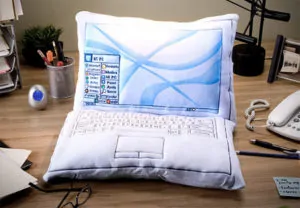Last modified 10/09/2023

Commercially known as laptop, it is a compact desktop computer. It has a portable design and friendly towards the user, because its components are structured and integrated in such way that its weight and size are reduced and it is much easier to transport than a regular desktop computer.
Its weight can vary from 1Kg. to 6 kg, depending on the devices and materials that have been used to manufacture the notebook. Its size also varies depending on the screen size and the number of devices integrated in the base of the notebook.
One of its disadvantages is that it always requires a power source or some kind of battery to keep the power supplied and the computer on. But the batteries do not provide an efficient energy supply, because you must always be borne by an energy source, and they typically have a short duration, so you got to have your computer plugged in through the battery.
The notebook does the same work as a desktop computer. The difference is in the device models used in the structure of the notebook, such as the hard drive, the RAM memory, the video card, the motherboard and the reader, which is constructed so tiny, attached to the compact frame of the notebook.
Historical background of the notebook :
In 1981 the first laptop was marketed, it was developed by the Osborne Computer Corporation, the problem was that this laptop was too heavy and it had a CRT screen; however, this developments in technology caused a great revolution for business and industrial strata.
In the year 1982, Bill Moggridge manufactured the Grid Compass 1101, which had an LCD screen that was coupled to the keyboard, it was hold inside a magnesium cabinet, and it could even be directly plugged into a power source or by batteries that supplied enough power to keep them on for a predetermined amount of time.
In the year 1983, Compaq released another laptop model, which used much better technology compared to the one used by the first laptop, as it was based on the design used by IBM. This new model was very successful business for companies.
Then, the superspot Dara System (ZDS) series was developed, competing in the labor market with huge companies such as IBM, Toshiba and Compaq, among others. This series were very successful and even went on to sell over 200,000 units to the U.S. Air Force. Furthermore, this series became popular for the common user, creating a better work field and education for the population.
In recent times, the laptop has undergone transformations that have led to surprising categorized as a true notebook.
It has improved the design and internal structure, to be able to achieve greater efficiency of the notebook. Each time they are improving the speed and appearance of the notebooks, but nothing can be completely perfect, since the fragility still remains to be one of its weakest points, which is very important for any device that is going to be constantly moved. Furthermore the parts used in the laptop can even achieve higher costs than the notebook itself.
Currently several companies are working on a new notebook with touch screen, which fits with the new requirements of the new technology at the software level.